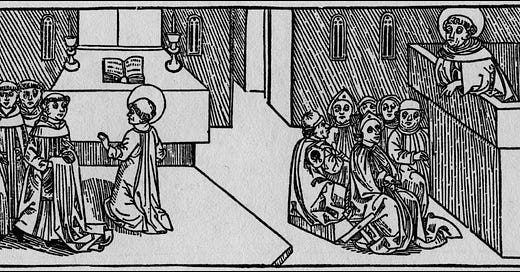There are only two sinless persons in the history of humanity. One is Jesus Christ, the Son of God, and the other is Mary, the Mother of God. St. Thomas teaches that since Jesus was fully God, he was incapable of sin. The question that naturally arises next is: Could Mary have sinned?
To gain some insight into this question, let’s see what Thomas has to say about the Blessed Virgin’s growth in holiness throughout her life.
Saint Thomas highlights three major events in our Lady’s life that enable her to conquer sin perfectly. These are:
Sanctification in the Womb (First Sanctification)
Sanctification during the Incarnation (Second Sanctification)
The Assumption
Thomas teaches that Mary increased in virtue every day until her Assumption. However, these three events enable her to remain completely unstained throughout her life. Let’s take a look at each one individually.
Sanctification in the Womb (First Sanctification)
…In her first sanctification, grace was bestowed efficaciously inclining her free decision toward the good, although not enough to remove her decision’s ability to bend toward evil, which even man in his first state had.
Thomas recognizes the need for Our Lady to be sanctified in a special way to prepare her to be the mother of Jesus. Mary was sanctified in her mother’s womb so that she might be rendered worthy to one day bear Christ in her womb. If you want to understand this sanctification better, check out our article on the Immaculate Conception.
Thomas believed Mary was sanctified in the womb of St. Anne and was given grace to “efficaciously incline her free decision toward the good.” This means that, before the Incarnation, Mary had a free will very similar to our First Parents in the Garden. She would not have been tempted by concupiscence (disordered desires of the flesh) as fallen humans are. Her natural inclination would have tended towards good. Mary would not have had desires contrary to reason. For example, after Mary had eaten a reasonable amount of food, she would not want to eat anymore, or after she had gotten a reasonable amount of sleep, she would have wanted to get up and begin her day. Her desires would have been ordered by reason without excess or defect.
According to Thomas, during this time in Mary’s life (from the womb to the Incarnation) Mary could have sinned but did not because of her excellence in grace, intense love for God, and protection by divine providence.
Sanctification during the Incarnation (Second Sanctification)
…In the second sanctification an additional grace was added that so filled the power of her free decision that she could not bend toward evil—not by removing the nature of the free decision, but by removing its defect.
Saint Thomas believes that after the Incarnation Mary received an abundance of grace so great that she “could not bend toward evil.” After conceiving Christ, Mary had a perfect free will that could no longer sin. The removal of the possibility of sin enhances her freedom by removing weakness and corruptibility from her will. To make an analogy, removing the possibility of defeat from a soldier makes him all-powerful. It is precisely because a soldier cannot lose that he is all-powerful. Similarly, Mary’s will is all-free precisely because she cannot be enslaved by sin or overcome by temptation.
St. Thomas uses this analogy to make the same point:
…The matter of the heavens, because it subsists under a form that excludes all privation from it, is not in potency to corruption.
To expand upon Thomas’ words here, any fire on earth can be put out with water. All fire is extinguished and corrupted if it is doused with enough water. However, the “matter of the heavens,” i.e. the stars, are not susceptible to being extinguished, and they are therefore free from the possibility of being corrupted. Mary’s will was so perfected at the Incarnation that it was no longer capable of being corrupted; just as no amount of water could extinguish the sun, so no amount of temptation could overcome Mary’s goodwill.
Lastly, the Assumption eliminates any remaining defects in Mary. Thomas teaches:
…In the Virgin’s third exaltation, she was joined to the end through a perfect grace drawing her into glory, which causes a perfect immobility.
Thomas thinks that in Our Lady’s first and second purifications, certain defects were removed and certain defects were allowed to remain in her for her greater glory. For example, the defect of having a will that could be turned to evil (although it never was) existed in her after her first sanctification so that she might prove her virtue and free cooperation with God. Likewise, the defect of being able to suffer and die like the rest of us remained in Mary after her second purification so that she might be able to empathize with us and suffer meritoriously for the salvation of our souls. Whatever defects remained in the wayfaring Virgin after the second purification were finally done away with in her Assumption when Mary was taken body and soul into heaven to be with her Son and like her Son in all things forever.
To conclude, here is Thomas’ own summary of the three sanctifications of Our Lady:
…there was a threefold perfection of grace in the Blessed Virgin. The first was a kind of disposition, by which she was made worthy to be the mother of Christ: and this was the perfection of her sanctification. The second perfection of grace in the Blessed Virgin was through the presence of the Son of God Incarnate in her womb. The third perfection of the end is that which she has in glory.
I hope this article deepens your understanding of Our Lady and, above all, increases your love for the Virgin Mary and her Son, Jesus Christ.
Reference:





Thank you again for this. I am a widow with limited financial freedom, but when I sell my house I will send you a thank you gift. In the meantime, please accept my gratitude and prayers. God bless you all.